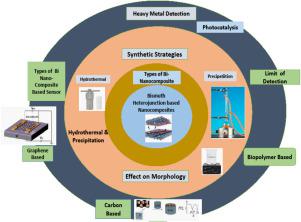Nano-Structures & Nano-Objects Pub Date : 2021-05-10 , DOI: 10.1016/j.nanoso.2021.100762 Maria Batool , Muhammad Faizan Nazar , Aneesa Awan , Muhammad Bilal Tahir , Abbas Rahdar , Ahmed Esmail Shalan , Senentxu Lanceros-Méndez , Muhammad Nadeem Zafar

|
Bismuth-based nanocomposites (BiNCs) have considered as interesting materials for applications in the fields of electrochemistry and optoelectronics, among others, due to their structural flexibility, high stability and facile manufacturing process. Their unique photo-oxidation properties are of particular interest in water splitting and pollutant degradation. The present review concern on the recent advances in architecting and morphology engineering bismuth-based heterojunction nanocomposites including bismuth-vanadate (BiVO), bismuth-tungstate (BiWO), bismuth-molybdate (BiMoO), and bismuth-chalcogenides (BiA; A = O, S, Se, Te), leading to enhanced efficiency of bismuthal nanocomposites through heterojunction assembly. As higher proficiency encourages environmental friendlier production, sustainable nanocomposites production approaches are highly needed in the scope of the circular economy paradigms. Thus, co-precipitation method and hydrothermal synthesis are discussed in detail due to their size selectivity, morphological variability, and reliability. This study paves the way toward the synthesis of more effective bismuthal nanocomposites with lower environmental impact. In addition, pollutants and biological components sensing capabilities of carbon, graphene and biopolymer-based BiNCs are discussed, signifying their role in environmental monitoring of heavy metals. Thus, the present review highlights the production of improved nanocomposites for photocatalysis and heavy metal sensors which are cost effective, reliable, reusable and efficient.
中文翻译:

铋基异质结纳米复合材料,用于光催化和重金属检测应用
铋基纳米复合材料(BiNCs)由于其结构上的灵活性,高稳定性和便捷的制造工艺,被认为是在电化学和光电子学领域中令人感兴趣的材料。它们独特的光氧化特性在水分解和污染物降解中特别引人关注。本综述关注建筑学和形态学工程领域的最新进展,包括钒酸铋(BiVO)的基于铋的异质结纳米复合材料。),钨酸铋(BiWO),钼酸铋(BiO)和铋硫属元素化物(Bi一种; A = O,S,Se,Te),从而通过异质结组装提高了双色纳米复合材料的效率。随着更高的熟练度鼓励对环境更友好的生产,在循环经济范式的范围内,迫切需要可持续的纳米复合材料生产方法。因此,由于共沉淀法和水热合成法的尺寸选择性,形态变异性和可靠性,它们被详细讨论。这项研究为合成更有效的具有较低环境影响的双色纳米复合材料铺平了道路。此外,还讨论了碳,石墨烯和基于生物聚合物的BiNC的污染物和生物成分感测功能,表明了它们在重金属环境监测中的作用。因此,











































 京公网安备 11010802027423号
京公网安备 11010802027423号